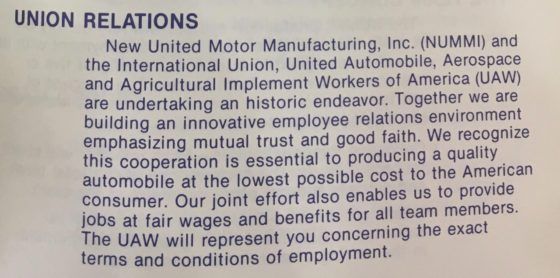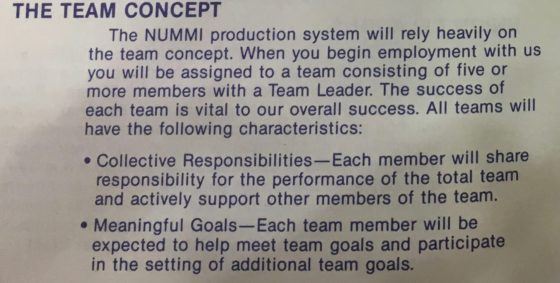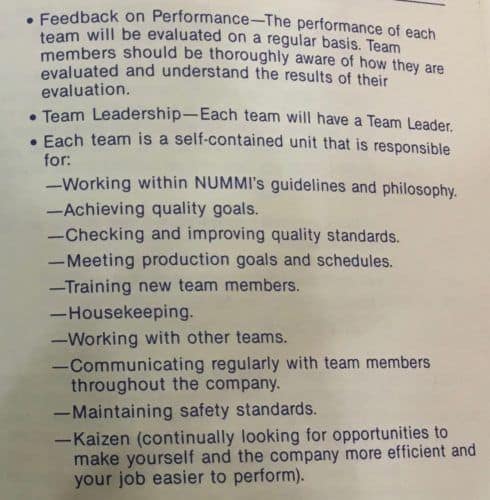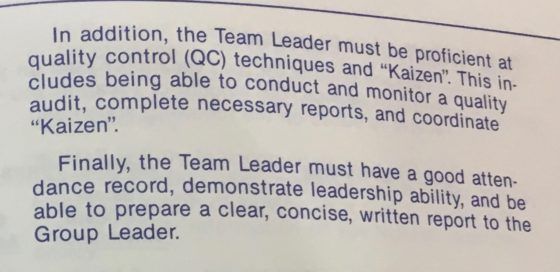 Here's Part 2 of a post about the original NUMMI Team Member Handbook from 1984 (see Part 1 here).
Here's Part 2 of a post about the original NUMMI Team Member Handbook from 1984 (see Part 1 here).
This, and other documents that I'll be blogging about, are part of Don Ephlin's UAW office papers that are archived at the Walter P. Reuther Library at Wayne State University in Detroit. Thanks to them for their assistance.
As we further explore the NUMMI handbook, the section on Union Relations also talks about teamwork and quality. Remember, that the NUMMI plant was reopened by Toyota and GM as a UAW plant, as it had been before, hiring from the same UAW workforce. Note that Toyota hired all new managers and taught them the Toyota Way.
“Mutual trust” was certainly “innovative” compared to the GM environment (and the GM plant I started my career at in 1995 didn't have mutual trust). Cooperation… joint efforts… that leads to quality, which leads to success, which leads to continued employment and wage increases.
Toyota probably didn't complain about the union as a barrier or excuse like GM did. Toyota had concerns about working with the UAW (as we'll see in future posts about other documents from the Ephlin Files).
The Team Concept
What did Toyota and NUMMI mean by the “team concept?” When I was at GM in 1995, the union agreement language talked about the “team concept” and the foremen were renamed “Team Coordinators,” but the new language didn't create a team environment until we got a new plant manager (who was one of the original NUMMI guys sent there from GM).
A Team Leader is the first level of supervision in a Toyota system, an hourly employee who can do the jobs on the line as a fill in, to do training, to help with problem solving, etc.
At GM, in 1995, we had an hourly employee in a role called “Assistant Team Coordinator,” but they were used as a fill-in team member for vacations, illnesses, and breaks. I don't remember the ATC being allowed to function like management.
More from the handbook:
Teams… note the emphasis on quality being listed before production goals and plans.
When I was at GM in 1995, the top priority was making your production numbers (quantity). I saw that same challenge at Dell Computer in 1999 and 2000.
Again, we see the emphasis on safety and Kaizen (or continuous improvement). I guess those two weren't listed last because they are the least important things. Toyota wouldn't want Team Members and Team Leaders prioritizing production numbers over safety.
Job Classifications
Another part of the Team Concept was NUMMI only having what look like four job categories for Team Members. When GM ran the plant, there were over 100 classifications (per this article: “Would the Toyota system work in U.S.? NUMMI was a test run“).
The four job classifications were:
- Production Team Members
- Skilled Trades
- Powerhouse/Facility Control
- General Maintenance
- Tool and Die Making
Toyota emphasized cross training, which provided additional flexibility:
Cross training — making sure employees are properly skilled and able to do different jobs — is key in a Lean system. You don't just throw a heart surgeon into brain surgery in the name of flexibility and efficiency. Safety and quality come first, which means not throwing somebody into a job assignment unless they're properly trained — an investment in that employee.
Awards & Incentives
Even though W. Edwards Deming always emphasized intrinsic motivation and the dysfunction that can come with awards. Deming was very influential and important to Toyota, but they still offered awards (or said they could):
I know the Toyota plant in San Antonio offers incentives for perfect attendance. I've heard that the Georgetown, Kentucky plan has done drawings for free Camrys and the price of entry for a team member is perfect attendance for the year (see an article from 2004).
“[In 2004] 4,273 team members achieved perfect attendance, which accounts for more than 60-percent of TMMK's workforce.”
But, does that create an unhelpful incentive for somebody to come to work when they're sick, spreading germs to others?
Team Leaders
What makes for an effective supervisor or Team Leader? Do organizations put enough thought into this, or do they just promote people who were good individual contributors?
Here's what the NUMMI handbook says about selecting Team Leaders (again, from the hourly ranks):
Today, do hospitals choose Charge Nurses and front line managers based on their ability to both do the jobs AND train and instruct people?
Are they given enough training (or any training) about how to train others effectively?
This is one area where the “Training Within Industry” method can be very helpful, especially in healthcare.
NUMMI also emphasized the ability to help others with Kaizen, or continuous improvement.
There's more to come in the third and final installment of these posts about the NUMMI Team Member Handbook.
How do you see these principles being applied in your organization? Or how could they be applied?
Please scroll down (or click) to post a comment. Connect with me on LinkedIn.
Let’s build a culture of continuous improvement and psychological safety—together. If you're a leader aiming for lasting change (not just more projects), I help organizations:
- Engage people at all levels in sustainable improvement
- Shift from fear of mistakes to learning from them
- Apply Lean thinking in practical, people-centered ways
Interested in coaching or a keynote talk? Let’s talk.
Join me for a Lean Healthcare Accelerator Trip to Japan! Learn More

















Nice post!
It is noteworthy that when Toyota people (old timers) talk about cost reduction, they mean EVERYTHING that could reduce costs. The obvious ones are less labor input, less inventory, lower prices on purchased materials. The less-obvious ones are balanced cycle times, short lead-time, and cross training. The important contributors to cost reduction that managers miss are “mutual trust and good faith,” teamwork, coaching, and cooperative relationships between union, labor, and management.
I’ve always been impressed at how well thought-out TPS is, as it has evolved over time due to changing circumstances, and, in particular, when it comes to human relations. The images shown above have a friendly tone, rather than a threatening tone. That also helps reduce costs.
Thanks for commenting again, Bob… more to come in this series… from the NUMMI handbook and other related documents from the UAW, Ford, and other sources.
Toyota originally wanted to partner with Ford, but ended up working with GM for a number of reasons.
It’s a shame how rare “mutual trust” in across different types of organizations.
Comments are closed.